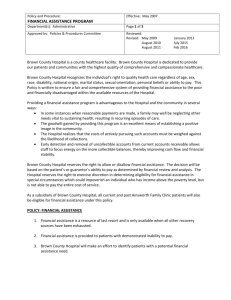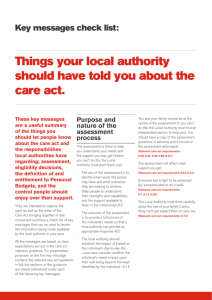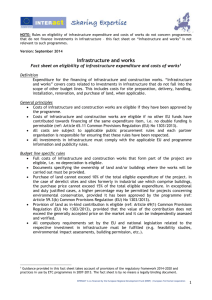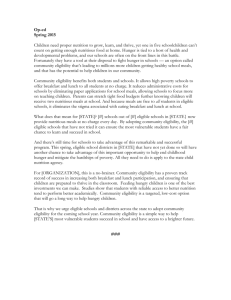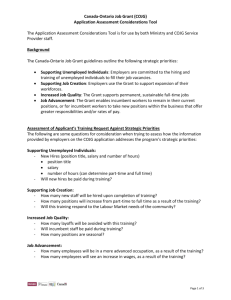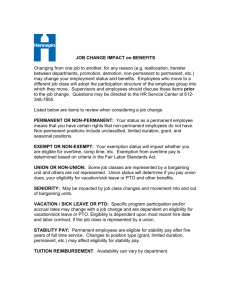Eligibility rules for the 2014 to 2020 European Regional
advertisement
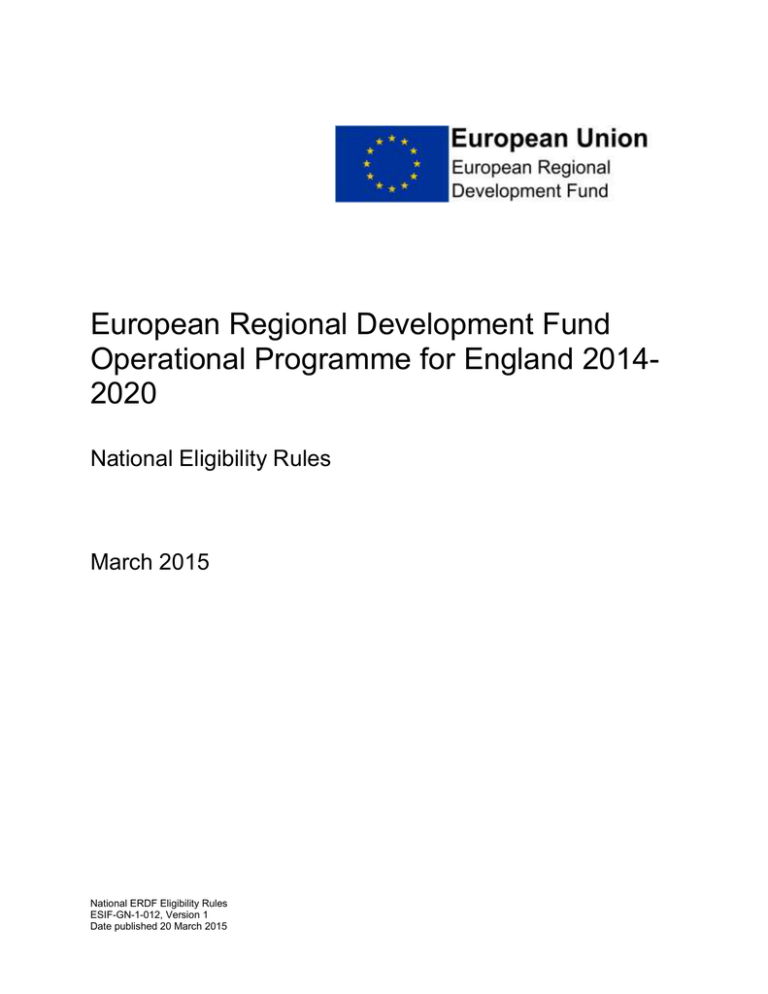
European Regional Development Fund Operational Programme for England 20142020 National Eligibility Rules March 2015 National ERDF Eligibility Rules ESIF-GN-1-012, Version 1 Date published 20 March 2015 Contents Page 1 Purpose/Introduction….…………………………………………………3 2 National Eligibility Rules ……………………………………………......3 3 Specific Rules – Europoean Union Legislation …...………………...4 Common Provisions Regulation (European Union) 1303/2013) ……………………………………………...…4 European Regional Development Fund Regulation, (European Union) 1303/2013) ……………………….….. ……….……… ….5 General Block Exemption Regulation (European Union) 651/2014) ……..………………………………………..…5 4. Who can apply for European Regional Development Fund…….….5 5 Location of Project.……………………………………………….……….7 6 Match funding (including Contributions in Kind)…...………….……7 7 Effective date for expenditure………………………….….……….……8 8 Eligible activities …………………………………………………………..9 9 Eligible capital costs…..…………………………………………………..9 10 Eligible revenue costs (direct and indirect costs)……………..…….10 11 Ineligible expenditure ………………………………..……………..…….12 National ERDF Eligibility Rules ESIF-GN-1-012, Version 1 Date published 20 March 2015 1. Purpose / Introduction 1.1 This document forms part of the legal basis for the implementation of projects cofinanced by the England European Regional Development Fund Operational Programme for the 2014-20 programme period. These Rules will remain under review and will be amended or updated as circumstances require. 1.2 This document sets out the National Eligibility Rules for the 2014-2020 European Regional Development Fund Programme in compliance with Article 65 of European Union Regulation 1303/2013 (the Common Provisions Regulation). All projects must comply strictly with eligibility rules. Failure to do so can lead to financial penalties of up to 100% of the grant being imposed. If the European Commission considers that there has been systemic failure on eligibility issues, they could enforce a flat rate correction to the whole of a Programme. European Regional Development Fund eligibility rules apply to all project spend included in the eligible costs, including match funding. 2. National Eligibility Rules 2.1 2.2 It is the grant recipient’s responsibility to ensure that the rules are strictly adhered to both during the project selection process and after approval. If there is any doubt, the Growth Delivery Team should be consulted. Eligibility rules applying to other sources of match funding (for example Local Growth Fund) cannot be used to justify departure from European Regional Development Fund eligibility rules. Projects must also comply with the priorities of the Operational Programme and the project selection criteria approved by the Programme Monitoring Committee in order to be awarded European Regional Development Fund. Projects must comply with the rules covering State Aid, Procurement and revenue generation where appropriate. Further details and guidance on these and other areas important to the preparation and delivery of European Regional Development Fund projects such as the application process, project management, assessing value for money and match funding can be found at: www.gov.uk/government/publications/european-structural-and-investmentfunds-project-requirements-and-publicity-materials https://www.gov.uk/government/publications/european-structural-andinvestment-funds-assessment-documents National ERDF Eligibility Rules ESIF-GN-1-012, Version 1 Date published 20 March 2015 2.3 Financial Instruments are complex and partners must take account of the specific legal and practical requirements applicable. The specific provisions are set out at Title IV of Regulation (European Union) No 1303/2013. Particular rules apply to eligible expenditure in different types of FIs such as Access to Finance funds and Urban Development Funds. These are described in detail in the Common Provisions Regulation, Articles 37 to 46, and in the Delegated Regulation European Union No 480/2014, Articles 4 to 14. 2.4 A non-exhaustive list of Regulations applicable to FIs is set out in Annex 1 of the Managing Authorities ‘Local Enterprise Partnerships and Partners Guide’ published on 10th November 2014. In addition, the European Commission publication “Financial Instruments in European Structural and Investment Funds programmes 2014-20 – A short reference guide for Managing Authorities” (http://ec.europa.eu/regional_policy/index.cfm/en/information/publications/g uides/2014/financial-instruments-in-esif-programmes-2014-2020-a-shortreference-guide-for-managing-authorities – 21/02/2014) sets out a useful overview of the main elements of the 2014-20 legislation. 3. Specific Rules – European Union Regulations 3.1 Provisions in the following European Union Regulations relate to eligibility of expenditure (ie the ability to claim reimbursement of funds) on projects (or ‘operations’) selected to be carried out under the England European Regional Development Fund Operational Programme:-: The Common Provisions Regulation Article 65 – Eligibility Article 69 - Specific eligibility rules for grants and repayable assistance Article 70 – Eligibility of operations depending on location Article 71 – Durability of Operations:Article 71 sets out the conditions applying to any project which involves investment in infrastructure or ‘productive investment’ and under its terms all (or a proportion of) the money must be paid back if: within 5 years (or the relevant period set out in State Aid rules), and, in any event, if the grant recipient is an small and medium sized enterprises National ERDF Eligibility Rules ESIF-GN-1-012, Version 1 Date published 20 March 2015 and the project involves maintenance of a capital (‘infrastructure’) project or one that creates jobs, within 3 years and any of the following applies: o the production stops or is relocated; o ownership of the infrastructure (building/capital investment) is changed, thus giving a firm/public body an undue advantage; o there is a substantial change in the project which has the effect of undermining its original objectives. Regulation European Union no 1301/2013 [the European Regional Development Fund Regulation] Article 3(1) sets out the types of activities that may be carried out to contribute to investment priorities in Article 4. Each priority axis in the Operational Programme includes one or more investment priority and sets out in more detail the types of actions to be undertaken and the guiding principles for selection. These broad definitions of activities underpin the more detailed rules specified in this document; Note that Art. 3(3) specifies the types of projects and undertakings that may not be supported by European Regional Development Fund. Regulation European Union no 651/2014 [the General Block Exemption Regulation] Separate guidance on State Aid in the context of European Regional Development Fund is available. Note that the provisions on Regional Aid (Article 13) of the General Block Exemption Regulation specify a number of sectors for which aid (ie, in this context, European Regional Development Fund) is not available. 4. Who Can Apply for European Regional Development Fund? 4.1 To apply for European Regional Development Fund, applicants must be a legally constituted body, and not an individual or sole trader. Depending on the nature of National ERDF Eligibility Rules ESIF-GN-1-012, Version 1 Date published 20 March 2015 the call, applicant organisations can be from the public or private sector. They will deliver projects using European Regional Development Fund investment to work with existing businesses or potential entrepreneurs to promote economic growth. Potential applicant organisations include, but are not limited to: 4.2 Local Authorities; Statutory and non-statutory public funded organisations/bodies; Higher and Further Education Institutions; Voluntary/community organisations; Private sector companies; Registered charities; Nor for Profit organisations. Whether from the public or private sector, most applicants will be operating as an undertaking and therefore any grant funding from the Department and/or through state resources, will have the character of state aid. Guidance on State Aid is at available at: www.gov.uk/government/publications/european-structural-and-investment-fundsproject-requirements-and-publicity-materials Delivery partners 4.3 Projects can be delivered by a consortium comprising a lead partner (the applicant) and specified partners (delivery partners). 4.4 The lead partner will be the applicant for grant and thus legally responsible for the delivery and compliance of the entire project, including activities delivered and expenditure incurred by any delivery partners. The lead partner must execute legally binding agreements to the satisfaction of the Department with each partner. No element of profit can be included. Applicants must demonstrate a sound rationale for the inclusion of delivery partners and be able to demonstrate that selection of delivery partners is not used to circumvent the procurement of service providers. National ERDF Eligibility Rules ESIF-GN-1-012, Version 1 Date published 20 March 2015 5. Location of Project 5.1 The England European Regional Development Fund Operational Programme operates on a National basis. All eligible European Regional Development Fund expenditure must benefit organisations located in England. 5.2 Special provisions exist for projects which cover two different categories of region, for example, transition and more developed and for Community Led Local Development and Sustainable Urban Development. 6. Match Funding - Including Contributions in Kind 6.1 The contribution from European Regional Development Fund finances only a specified percentage of the total eligible costs of a project. The percentage is based on different factors:- (i) The categorisation of the region (as ‘less developed’, ‘more developed’ or ‘transitional’; (ii) State Aid, either General Block Exemption Regulation or any other notified scheme, together with the size of the enterprise where they are a grant applicant (whether Small, Medium or Large) will also have an effect on the (total) level of permissible funding; and applicants should be fully aware of the effect of accumulation of aid, particularly if one undertaking is conducting a number of related projects. 6.2 The funding for the remaining balance of eligible costs (known as match funding) must be available from the outset. It may come from the applicants themselves (and any delivery partners’ resources), or from other organisations in the public or private sector. Match funding from small and medium sized enterprises is allowed, provided it does not count as revenue to the grant recipient under Article 61. Revenue European Regional Development Fund projects may use capital match funding and vice versa provided the need for European Regional Development Fund can be demonstrated. 6.3 The match funding must be identified and secured by the applicant during the application process and be available to enable the project to be delivered as set out in the European Regional Development Fund funding agreement. 6.4 ‘Contributions in kind’ are ineligible as match funding, except for the donation of land and buildings subject to the conditions below:National ERDF Eligibility Rules ESIF-GN-1-012, Version 1 Date published 20 March 2015 (a) In capital projects, the value of land or buildings donated so as to form part of the project may be counted as a ‘contribution in kind’ which will add to the value of eligible expenditure, as long as all the criteria set out in Art 69 Common Provisions Regulation are met. (b) Funds used to invest in infrastructure or productive investment (which includes any kind of capital ‘build’ project that fits within a relevant Priority Axis) must be repaid if within five years of the final payment (or whichever time period is specified in a relevant State Aid scheme/rules) there is a change of ownership (giving an undue advantage to another firm or public body) or a substantial change in the operation, once complete, which undermines its original objectives (see Art.71 Common Provisions Regulation). For this reason, grant applicants must, at the outset of the project, be in a position to offer binding covenants as to the use of the property which is the site of the relevant operation/project. Staff costs 6.5 The funding for eligible staff costs can be included as match funding but only where the employing organisation is the applicant or any delivery partner including in the funding agreement. Separate rules relating to simplified costs including staff costs are provided. 7. Effective Date for Expenditure 7.1 The effective date for incurring eligible European Regional Development Fund expenditure is the date the project is formally selected into the programme following agreement on the outline application, subject to meeting the criteria set out in paragraph 7.2, unless there are exceptional circumstances. Any expenditure incurred by a project prior to this date is ineligible. Outline approval of a project does not guarantee it full approval. 7.2 All cases for retrospection must be subject to: The applicant agreeing, in writing, to accept any financial liabilities should the project subsequently fail to receive full approval; the applicant and operation meeting any Managing Authority retrospection criteria; the case for retrospection being supported by strong, clear, written evidence and subsequently fully agreed by the Managing Authority; and National ERDF Eligibility Rules ESIF-GN-1-012, Version 1 Date published 20 March 2015 any additional retrospection tests to be carried out by the MA being fully undertaken and passed before payment is made. 8. Eligible Activities 8.1 8.2 Article 5 of European Regional Development Fund Regulation sets out 11 thematic objectives that can be funded by European Regional Development Fund, together with the investment priorities that underpin each one. However, the Priority Axes set out in the Operational Programme cover the following seven thematic objectives:- Strengthening research, technological development and innovation Enhancing access to, and use and quality of, Information Communication and Technology Enhancing the competitiveness of Small and Medium Sized Enterprises Supporting the shift towards a low carbon economy in all sectors Promoting climate change adaptation, risk prevention and management Preserving and protecting the environment and promoting resource efficiency Promoting sustainable transport and removing bottlenecks in key network infrastructures (Cornwall and the Isles of Scilly). Projects will be selected for support from European Regional Development Fund using approved criteria (specified in a separate document) which are designed to ensure that operations will contribute to the achievement of the specific objectives and results of the relevant priority (Art 125(3) Common Provisions Regulation) 9. Eligible Capital Costs 9.1 Capital expenditure is eligible for European Regional Development Fund support where the activity fits the scope and objectives of Article 3 of the European Regional Development Fund Regulation and the Operational Programme and relates to a specific Call for proposals. 9.2 Capital costs must fit within one of the following expenditure headings: Land acquisition; building acquisition; site investigation; site preparation; building and construction; plant and machinery; research equipment; associated fees. National ERDF Eligibility Rules ESIF-GN-1-012, Version 1 Date published 20 March 2015 i. Capital expenditure that cannot be clearly demonstrated as directly related to the delivery of an activity may not be included within the eligible costs of an European Regional Development Fund operation. This includes buildings that are not directly linked to the cost and purpose of the operation and second-hand equipment that has been previously purchased with European Regional Development Fund grants. The costs included must not exceed the market value. ii. The cost of purchasing land may not exceed 10% of total eligible operational costs. This may be increased to 15% in the case of derelict sites and former industrial sites with buildings. iii. Depreciation costs cannot be included. iv. All capital costs must be actual, notional amounts will not be accepted including fees charged between departments within the same organisation. 9.3 Article 71 of Regulation1303/2013 specifies the period for which European Regional Development Fund funded capital infrastructure is expected to comply with the conditions of its approval, including location, ownership or nature. This also applies to land and buildings donated as Contributions in Kind. 10. Eligible Revenue Costs 10.1 European Regional Development Fund Revenue expenditure categories are set out below and projects must define costs under the following expenditure categories for the purposes of submitting a project proposal and grant claims. Direct Staff Costs These should include staffing costs for personnel directly engaged on the project. The costs should include benefits which are part of the contractual conditions, National Insurance and Superannuation contributions. Costs can be related to internal (employed) or non-procured external staff (contracted) and Agency staff. Exclusions include: All staff who do not perform a role directly associated with the delivery of the project, that is those performing supporting roles such as reception, central National ERDF Eligibility Rules ESIF-GN-1-012, Version 1 Date published 20 March 2015 finance, IT support and organisation management. Costs of business travel, subsistence and accommodation as this would be a direct cost not a direct staff cost. A methodology to determine the direct costs of part time staff using an hourly rate unit cost has been made available by Article 68(2) of 1303/2013. The hourly rate is the cost of a project staff member who does not spend 100% of their time on the project based on salary and on costs determined by dividing the latest documented annual gross employment costs by 1720 hours. Other Direct Costs These are costs which are directly related to the delivery of the project activity and are not shared or apportioned. Specific examples are listed below; the list is not exhaustive: Contractors and consultants who have been procured to work on the project and claim against their invoice value Fees; use of independent consultants/contractor if essential to the project and, similarly for independent project evaluations. In both these cases there should not be double counting of fees under capital expenditure Accounting and audit costs, can be claimed if they relate to requirements imposed by the Managing Authority. The cost of guarantees, provided by a bank or other financial institution only where such guarantees are required by National or community legislation can be included; Bank transaction costs, are eligible but not debt interest; Any expenditure related to marketing and publicity should also be included here; Premises costs such as rent, gas, electricity, water and insurance can only be included here if used exclusively for the delivery of a project. Exclusions include Any costs claimed under direct staff costs Shared/apportioned costs – including shared/apportioned premises and running costs National ERDF Eligibility Rules ESIF-GN-1-012, Version 1 Date published 20 March 2015 Lost opportunity costs Depreciation costs The following costs are not eligible expenditure:- Payments that support activity intended to influence or attempt to influence the UK Parliament, Government, political parties, European Union Institutions,, or attempting to influence the awarding or renewal of contracts and grants, or attempting to influence legislative or regulatory action in the United Kingdom or the European Union. Indirect Costs In accordance with Article 68 (b) of the Common Provisions Regulation, where the implementation of a project gives rise to indirect costs, grant recipients may claim European Regional Development Fund using one of the following flat rate percentages to specific categories of eligible costs for the calculation of indirect costs. In accordance with Article 67 (4), this methodology will apply to all European Regional Development Fund projects, including Financial Instruments, which are not implemented exclusively through a public procurement exercise. The table below sets out the flat rate methodologies available to the European Regional Development Fund programme:Category of Eligible Costs Eligible Direct Staff Costs Flat Applicability Rate European Regional 15% Development Fund Article 68(b)1303/2013 Eligible Direct costs 25% National ERDF Eligibility Rules ESIF-GN-1-012, Version 1 Date published 20 March 2015 For eligible research and Innovation (R&I)Activity (similar activity and beneficiary in Horizon 2020) For European Structural and Investment funds where they invest in appropriate R&I activity as defined by Art 29 1290/2013 and Article 20 of Commission delegated regulation 480/2014 and consistent with European Regional Development Fund Programme Objectives Any requirements and/or Restrictions No requirement to perform calculation to determine the rate excluding subcontracting costs , and the costs of resources made available by 3rd parties not used on the premises of the beneficiary and financial support to 3rd parties
